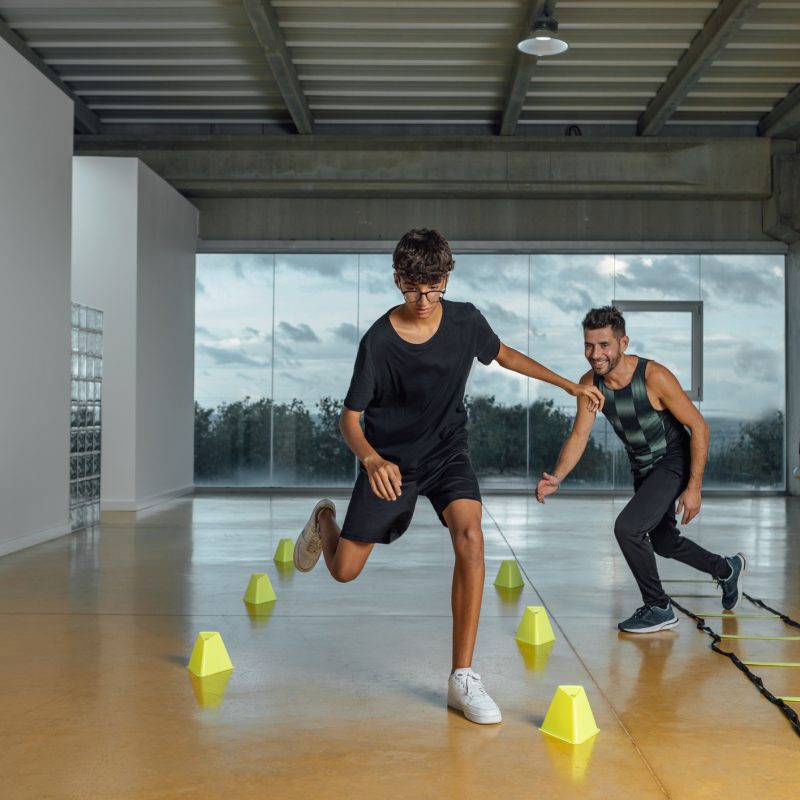
Reactive Training, a fairly new concept in the wellness community, shows great promise both in enhancing performance gains and diminishing risk of injury. This form of training seems successful in athletes of all ages and fitness levels. The Core-Tex company designed a piece of equipment which focuses on such reactive training, offering a myriad of benefits to the physical and neurological aspects of the human body. Here we explore how to incorporate reactive training sessions into clients’ regular workout programming, as well as detailing the science behind these unique movements.
The Human Body and Unpredictability
Regardless of the population or the activity, one’s ability to react and generate force quickly and safely lies at the very core of functional movement. Reactive/power training can enhance one’s ability to stabilize while moving, slowing down and/or stopping, and produce forces at speeds best served for the tasks at hand.
Reactive training involves the integration of dynamic and often unpredictable movements to bring about rapid, coordinated responses from the body’s musculoskeletal and nervous systems. In contrast to traditional exercises performed perhaps in a single plane or position — push-up’s, lunges, controlled stretching — reactive training places its emphasis on enhancing the ability to react swiftly to whatever external stimuli the body may encounter at any point in time. Such training benefits agility, coordination, and overall functional fitness.
The human body boasts the exquisite capacity to adapt to various challenges and ever-changing external stimuli. Reactive training leverages this adaptability by incorporating movements that necessitate quick adjustments and precise muscle recruitment. This type of training not only strives to mimic potential real-life situations, but also boosts neuromuscular control and proprioception.
The Core-Tex Advantage
Core-Tex, a unique piece of equipment rapidly attaining a position of prominence in the world of reactive training, offers a multitude of advantages to fitness buffs and elite athletes alike. Cradled within a base that encases ball transfers oriented to support the convex underside of the platform, this design features the ability to tilt and rotate in multiple directions. The 360-degree swivel creates endless movement options; and such free-form movement challenges body stabilization while simultaneously activating a wide range of muscles.
Below we highlight the many ways in which Core-Tex Reactive training can enhance any client’s workouts, regardless of their chose sport:
- Multi-Planar Movement ~ Core-Tex’s design allows for movement in the lateral, frontal, and transverse plans, much like daily life. This challenges the body to adapt to varying directions, allowing for an all-inclusive workout experience.
- Unpredictability ~ A Core-Tex workout’s ever-changing movements require users to constantly adjust their body positioning. This challenges the neuromuscular system, fostering improved proprioception and kinesthetic awareness.
- Improved Functional Fitness ~ By engaging multiple muscle groups while challenging the body’s natural movement patterns, reactive training with can enhance overall functional fitness.
- Enhanced Neuromuscular Coordination ~ The dynamic and unpredictable nature of Core-Tex movements promotes better neuromuscular coordination, translating intohttps://personaltrainertoday.com/functional-training-personal-trainers improved athletic performance and reduced risk of injuries.
- Increased Core Strength ~ The constant need for stabilization activates the core muscles, leading to stronger and more stable abdominal, back and hip muscles.
Strengthening While Sitting
In addition to the muti-planar movement possibilities offered by the Core-Tex Trainer, sitting on this piece of equipment can actually help the core and lower back, common areas of concern for many individuals. By creating a variable sitting environment, its patented design turns sitting into a dynamic experience, conferring benefits to the lower back, hips, core and pelvic floor.
By sitting on a Core-Tex Trainer throughout an 8-hour workday, as opposed to a traditional office desk chair, users can derive the following benefits ~
- Prevents stress from accumulating on the lower back
- Strengthens abdominal/low back muscles
- Improves posture and focus while working
- Relieves tension and pressure from scoliosis; may help correct postural imbalances
Real Life Forces
Reactive training can include plyometric movements, powerlifting, and strength building workouts. It forces one to focus on quick, powerful and explosive movements, all of which require muscle contractions.
When a client or athlete performs a powerful movement, muscles eccentrically and concentrically contract quickly. The eccentric contraction, known as the loading phase, contains reduced force, while the explosive concentric contraction causes force production. A concentric movement incorporates the stretch capabilities of muscle tissues to store potential energy, utilizing it as kinetic energy (the energy of motion) when called upon to generate force efficiently. The amortization phase represents the transition between the two aforementioned muscle contractions. The quicker an athlete can move from one to the other, the better his reactive strength.
The nervous system enables all movement throughout the entire body. Motor neurons transmit signals from the spine to all the skeletal muscle within the body. Reactive training can help with the body’s physical mobility responses. The shorter the motor response time, the quicker the movement. Clients can benefit from this form of reactive training, helping their bodies adapt to making faster movement decisions while still maintaining a high-performance output. Reactive training serves an important purpose for everyday recreational clients as well, assisting them in activities of daily living.
When helping a client with a reactive training workout program, trainers will do well to keep in mind the key purpose of reactive training: recruiting as many muscle fibers as possible, in the shortest amount of time. This in turn fosters better neuromuscular efficiency and increases a client’s ability to produce force. The more force a client can produce, the stronger he grows. This also works well for the client whose goals include fat burning and muscle hypertrophy.
Reactive Training and Injury Prevention
If an athlete’s body learns to produce significant amounts of force in a short time, he will witness a dynamic increase in his sports performance. This transfer of power contributes to speed, agility, strength and overall physical conditioning. To recruit fast-twitch muscle fibers, the body must have the capacity move rapidly.
When a client’s body can withstand sudden movements, he inherently lessens his injury risks.
Consider the example of two basketball players of equal height reaching for a jump ball; the one who can react/generate force the fastest will win the toss. The same holds true for the overall population. If upon stepping off a curb, a client loses his balance and falls, perhaps his nervous system needs reactive training. A nervous system trained to react quickly can recruit the necessary muscles at the right time, enabling an individual to regain his balance and decrease his chance of incurring a serious fall or injury. Fitness professionals suggest not incorporating reactive training into a novice client’s program, however, until he has obtained proper flexibility, core strength, and balance capabilities.
For clients attempting to gain muscle mass, even a slight injury can render them temporarily sidelined, thereby limiting growth potential. To avoid injuries, the body must stabilize and move at the various speeds with which our bodies naturally mobilize during everyday activities. If a personal trainer fails to work a client at a variety of speeds, his body does not know how to react when forced to move and, more importantly, stabilize at those speeds. This makes the client vulnerable to injury. Reactive training teaches how to effectively stabilize at various joints, maintain postural equilibrium at faster speeds, and utilize proper landing mechanics to increase force production when needed. Consider this mode of training as preparing for life’s little surprises in a safe, controlled environment. In this manner, when faced with a real-life situation, the brain and nervous system already mastered a management strategy.
Understanding Neuromuscular Efficiency
Neuromuscular efficiency, also known as NME, refers to the efficiency of the nervous system and muscles as they work together to produce movement. Factors that influence NME include muscle contraction timing, coordination, force production, and the skill to perform the movement at hand. High NME allows an athlete to execute complex movements smoothly and efficiently without generating tremendous fatigue. This benefit serves endurance athletes well throughout longer, challenging races/competitions.
Neuromuscular efficiency can serve as a reliable indicator of muscle function and strength, as well as the ability to activate motor units which can then produce force and create movement. The higher the value, the more efficiently athletes can perform their sport’s required movements, and with more precision and control as well. These factors typically favor a lessened chance of injury. Keep in mind that the nervous system will only recruit muscles at speeds for which one trains it. If the nervous system never gets exposed to/challenged by quick muscle recruitment, it will fail to respond appropriately.
Final Thoughts
Every activity we perform, whether on the playing field or throughout an average day, requires us to generate force quickly in response to the demands place on our bodies. By training at speeds functionally applicable to everyday life as well as one’s chosen sport, we can decrease the risk of injury and enhance overall performance.
If a client wishes to work more efficiently, burn a few extra calories and fast-track his fitness goals, consider adding Core-Tex exercises to his workouts. Creativity, fun and fitness await!
References
https://coretexfitness.com/?srsltid=AfmBOoqUKtpDoEYCLzPV6cUMWvkgz9AfdrXo2gssSu1wAwO1vvhF8rXb
https://www.issaonline.com/blog/post/should-you-add-reactive-training-to-your-fitness-program
https://blog.nasm.org/training-benefits/the-importance-of-reactivepower-training#:~:text=Reactive%20Training%20is%20defined%20as,concentric%20contraction%20(produce%20force).
https://www.dotfit.com/content-1456.html
Neuromuscular Efficiency: Definition, Benefits, and How to Improve It






